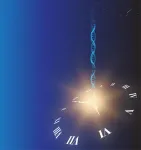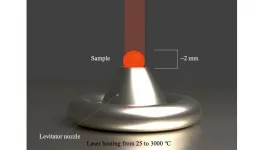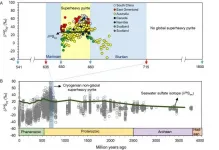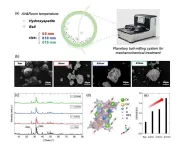(Press-News.org) A new study from the University of Chicago has found that the photosynthetic bacterium Synechococcus elongatus uses a circadian clock to precisely time DNA replication, and that interrupting this circadian rhythm prevents replication from completing and leaves chromosomes unfinished overnight. The results, published online on May 10 in Proceedings of the National Academy of the Sciences, have implications for understanding how interrupted circadian rhythms can impact human health.
Circadian rhythms are the internal 24-hour clock possessed by most organisms on earth, regulating a diversity of biological functions including sleep/wake cycles, hormone production, digestion and body temperature. In humans, disruptions to the circadian rhythm -- such as working a shift-work job or experiencing frequent jet lag -- have been associated with an array of health problems, including obesity, cardiovascular and immune dysfunction, mood disorders and even cancer.
"In most species we've studied, if the circadian rhythm is disrupted or permanently changed, it's bad for the animal's health, but no one has really been able to explain what goes wrong if your clock is in the wrong state all the time," said senior author Michael Rust, PhD, Associate Professor of Molecular Genetics and Cell Biology at UChicago. "This cyanobacterial system is exciting because it gives us a chance to answer these mechanistic questions about how circadian rhythms are contributing to the health of an organism."
Despite the large evolutionary gap between humans and cyanobacteria, these tiny organisms can provide insights into critical cellular functions such as DNA replication. "The evidence suggests that circadian rhythms have evolved multiple times among different species, so there must be something very fundamental and important that's shared among these different species," said first author Yi Liao, a postdoctoral scholar in Rust's lab. "DNA replication is also a fundamental process, shared across species, which gave us a clue that it might be regulated by this clock."
The investigators were particularly interested in studying this process due to its lengthiness. "Some things are better to do during the day, like photosynthesis, while others are better at night, like fixing nitrogen," said Rust. "But DNA replication takes three to four hours to replicate the entire genome, so there's a fundamental need to predict the future. You commit to doing this thing and you don't know what the conditions will be like a few hours later. It seemed like maybe this process would use circadian rhythms to 'predict' the right time to start replication to ensure that it finishes during an optimal window of time."
Combining time-lapse fluorescent microscopy, mathematical modeling, molecular genetics and biochemical approaches, Liao and Rust were able to track DNA replication initiation, completion, and failures in bacteria exposed to different illumination patterns, including constant light, normal light/dark cycles and cycles with unexpected periods of darkness.
They found that the circadian clock creates rhythms in DNA replication even in the absence of environmental cues, such as the rising and setting sun. DNA replication typically begins when the clock state corresponds to the morning, and is suppressed when the clock predicts the arrival of night. However, when the internal clock of the bacteria predicts morning but the external environment unexpectedly becomes dark, ongoing replication can't be completed; the replication machinery disassembles, leaving cells with incomplete chromosomes.
"Many things are regulated by the circadian clock, but it is striking that it matters so much for DNA replication," said Rust. "If the clock is in the wrong state, it's the difference between completing the replication event, or the replication machinery falling apart completely."
These results, Liao says, open up even more questions. "What is the fate of these unfinished chromosomes? Does this lead to mutations?" he said. "Maybe this is a major driving force in the evolution of the circadian clock -- you want to avoid damaged DNA and unfinished chromosomes, so the clock has evolved multiple times in history to prevent those things from happening."
In a post-Industrial Revolution society, surrounded by artificial lights that can be turned on and off at will, these results could have implications for how circadian rhythms impact human health and why extensive disruptions can be so damaging.
"One question that we still need to answer is whether or not this failure to complete DNA replication leads to mutation and genomic instability," said Rust. "Organisms may experience unexpected darkness on occasion, but their clocks get very strong signals from the cycle of the sun rising and setting. In humans, where we can control the illumination of our environment and ignore the sun, we know there are changes in the circadian rhythm and we know it causes problems, but it's not clear where those problems come from. We're trying to put our finger on a molecular mechanism for what might be the biggest problem if your circadian clock is in the wrong state."
INFORMATION:
The study, "The circadian clock ensures successful DNA replication in cyanobacteria," was supported by the Howard Hughes Medical Institute (Simons Faculty Scholar award) and the NIH (R01-GM107369).
About the University of Chicago Medicine & Biological Sciences
The University of Chicago Medicine, with a history dating back to 1927, is one of the nation's leading academic health systems. It unites the missions of the University of Chicago Medical Center, Pritzker School of Medicine and the Biological Sciences Division. Twelve Nobel Prize winners in physiology or medicine have been affiliated with the University of Chicago Medicine. Its main Hyde Park campus is home to the Center for Care and Discovery, Bernard Mitchell Hospital, Comer Children's Hospital and the Duchossois Center for Advanced Medicine. It also has ambulatory facilities in Orland Park, South Loop and River East as well as affiliations and partnerships that create a regional network of care. UChicago Medicine offers a full range of specialty-care services for adults and children through more than 40 institutes and centers including an NCI-designated Comprehensive Cancer Center. Together with Harvey-based Ingalls Memorial, UChicago Medicine has 1,296 licensed beds, nearly 1,300 attending physicians, over 2,800 nurses and about 970 residents and fellows.
Visit UChicago Medicine's health and science news blog at http://www.uchicagomedicine.org/forefront.
Twitter @UChicagoMed
Facebook.com/UChicagoMed
Facebook.com/UChicagoMedComer
Argonne scientists across several disciplines have combined forces to create a new process for testing and predicting the effects of high temperatures on refractory oxides.
Cast iron melts at around 1,200 degrees Celsius. Stainless steel melts at around 1,520 degrees Celsius. If you want to shape these materials into everyday objects, like the skillet in your kitchen or the surgical tools used by doctors, it stands to reason that you would need to create furnaces and molds out of something that can withstand even these extreme temperatures.
That's where refractory oxides come in. These ceramic materials can stand up to blistering heat and retain their shape, which makes them useful for all kinds of things, from kilns ...
May 11, 2021 - Like other medical specialties at the start of the COVID-19 pandemic, orthopaedic surgery rapidly pivoted from in-person visits to remote appointments via telemedicine. Analysis of that initial experience finds that some groups of patients faced persistent or worsening disparities as the shift to telemedicine occurred, reports Clinical Orthopaedics and Related Research® (CORR®), a publication of The Association of Bone and Joint Surgeons®. The journal is published in the Lippincott portfolio by Wolters Kluwer.
"We found concerning disparities in access ...
TAMPA, Fla. - A hallmark of cancer is its ability to evade the immune system. It is why researchers are focused on finding new strategies and targets to jumpstart the immune system so it can mount a response against tumors. One such target is the inhibitory receptor T-cell immunoglobulin and mucin domain 3 (TIM-3), a protein that is overexpressed in many different types of cancer and is associated with poor patient outcomes. It is known to block the activity of immune cells, such as dendritic cells, but how remains unclear. In a new article published in the journal Immunity, Moffitt Cancer Center researchers show that TIM-3 inhibits the STING signaling pathway in dendritic cells, thereby blocking their ability to elicit an immune response.
Dysregulation ...
Point:
Novel chiral diacid monomers were synthesized.
Chirally interactive BioNylons were prepared.
BioNylon showed thermal/mechanical performances than conventional Nylons.
BioNylons disintegrated and degraded with pepsin.
Summary:
Marine plastic waste problems have been more serious year by year. One of the worst issues is that creatures in ocean are going extinct by mistakenly swallowing them.. Conventional biodegradable plastics are degradable in digestive enzymes, but their performances are too low to use in society. In this study, researchers from JAIST have used bio-derived resources such as itaconic acid and amino acid for the syntheses of high-performance BioNylons having the pepsin degradation function.
Ishikawa, ...
Quantum mechanics can be used to create more stable and more easily produced organic solar cells. These are the findings of new research from the University of Gothenburg.
Organic solar cells have many advantages compared with traditional silicon-based solar cells. They can be manufactured cheaply at a large scale using printing presses, and they are light, malleable and flexible. The problem is that today's organic solar cells are not as stable and effective as silicon-based solar cells. In a new study, a research group has taken on this problem and found a way that can lead to more cost-effective solar cell technology.
"There are excellent opportunities for utilising quantum efficiencies to change different chemical ...
The Sturtian Snowball Earth glaciation (717~660 million years ago) represents the most severe icehouse climate in Earth's history. Geological evidence indicates that, during this glaciation, ice sheets extended to low latitudes, and model simulations suggest global frozen ocean as well as a prolonged shut-down of the hydrological cycles. The Snowball Earth hypothesis poses that the Sturtian global glaciation is directly triggered by intense continental weathering that scavenges atmospheric CO2, while the global frozen condition is terminated by ...
One of the most basic structural aspects of relativistic spacetime is the description of how time and distances are altered by motion. The theory of special relativity describes a spacetime framework for linear constant motion in which time dilates and lengths contract in response to motion. This framework is described by the Lorentz transformation, which encompasses mathematical formulas that describe how time and distance are altered between moving reference frames. The Lorentz transformation also describes how a stationary observer views time in the moving frame to be offset with distance. ...
One of the most prominent evils of rapid industrialization has been the emission of toxic pollutants into the surrounding biosphere, with often disastrous consequences for human beings. Several industrial processes, such as chemical manufacturing and printing, along with facilities such as power plants emit volatile organic compounds (VOCs) that are known to be cancer-causing and raise an important environmental issue in need of a solution. Traditionally, VOCs are controlled via a process called "catalytic oxidation," in which they are converted into benign materials in the presence of noble metal (e.g. gold, silver, and platinum) ...
A new study from the University of Surrey has revealed 'real world' factors that influence people's interest in adopting a dietary pattern called time-restricted feeding.
According to NHS England, 67 per cent of men and 60 per cent of women in the UK are overweight or obese - with more than 11,000 yearly hospital admissions directly attributable to obesity.
Time-restricted feeding, which is a type of intermittent fasting, is the practice of restricting the time between the first and last food intake each day - therefore prolonging the daily fasting period.
In a study published by the ...
A new study from the University of Portsmouth calls for further government oversight to curb potential illegal activity through these zones.
This study demonstrates the attractive trading advantages offered by freeports to enable enterprise and innovation. Eight new freeports in England are due to enter operation in late 2021, which are hoped to drive investment, economic opportunities and growth to those regions.
However, researchers also advise that stronger regulation is needed to prevent Freeports being abused for money-laundering and tax-evasion purposes. The study, ...




